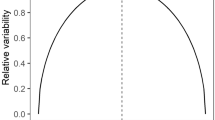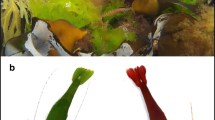Abstract
Bright coloration among unpalatable prey is common1. Turner2 has suggested that, as with Fisher's explanation for the evolution of distastefulness itself3, such aposematic coloration has been favoured by kin selection. Distasteful aposematic prey tend to live in kin groups and predators sampling from such groups will learn to avoid conspicuous prey more readily than cryptic prey and, as a consequence, fewer members of conspicuous kin groups are preyed upon2,4–6. We know of no clear evidence that vertebrate predators take fewer trials when learning to avoid conspicuous rather than cryptic distasteful prey6,7. Here we report results from a series of experiments that provide such evidence.
This is a preview of subscription content, access via your institution
Access options
Subscribe to this journal
Receive 51 print issues and online access
$199.00 per year
only $3.90 per issue
Buy this article
- Purchase on Springer Link
- Instant access to full article PDF
Prices may be subject to local taxes which are calculated during checkout
Similar content being viewed by others
References
Edmunds, M. Defence in Animals (Longmans, Harlow, 1974).
Turner, J. R. G. Nat. Hist. 84, 28–37 (1975).
Fisher, R. A. The Genetical Theory of Natural Selection (Clarendon, Oxford, 1930).
Rettenmeyer, C. W. A. Rev. Ent. 15, 43–74 (1970).
Matthews, E. G. Am. Nat. 111, 213–222 (1977).
Harvey, P. H. & Greenwood, P. J. in Behavioural Ecology: an Evolutionary Approach (eds Krebs, J. R. & Davies, N. B.) 129–154 (Blackwell, Oxford, 1978).
Gittleman, J. L., Harvey, P. H. & Greenwood, P. J. Anim. Behav. (in the press).
Gittleman, J. L. thesis, Univ. Sussex (in preparation).
Willis, A. J., McEwan, J. W. T., Greenwood, J. J. D. & Elton, R. A. J. Anim. Ecol. (in the press).
Author information
Authors and Affiliations
Rights and permissions
About this article
Cite this article
Gittleman, J., Harvey, P. Why are distasteful prey not cryptic?. Nature 286, 149–150 (1980). https://doi.org/10.1038/286149a0
Received:
Accepted:
Issue Date:
DOI: https://doi.org/10.1038/286149a0
This article is cited by
-
How to move and when to escape: quantifying intraspecific exploratory and anti-predator behavior in an aposematic poison frog
Evolutionary Ecology (2024)
-
The molecular basis and evolution of toxin resistance in poison frogs
Evolutionary Ecology (2023)
-
First report of Hierodula transcaucasica (Brunner von Wattenwyl, 1878) predation on the Halyomorpha halys (Stål, 1855) in Georgia
International Journal of Tropical Insect Science (2022)
-
Social transmission in the wild can reduce predation pressure on novel prey signals
Nature Communications (2021)
-
Artificial eyespots on cattle reduce predation by large carnivores
Communications Biology (2020)
Comments
By submitting a comment you agree to abide by our Terms and Community Guidelines. If you find something abusive or that does not comply with our terms or guidelines please flag it as inappropriate.



